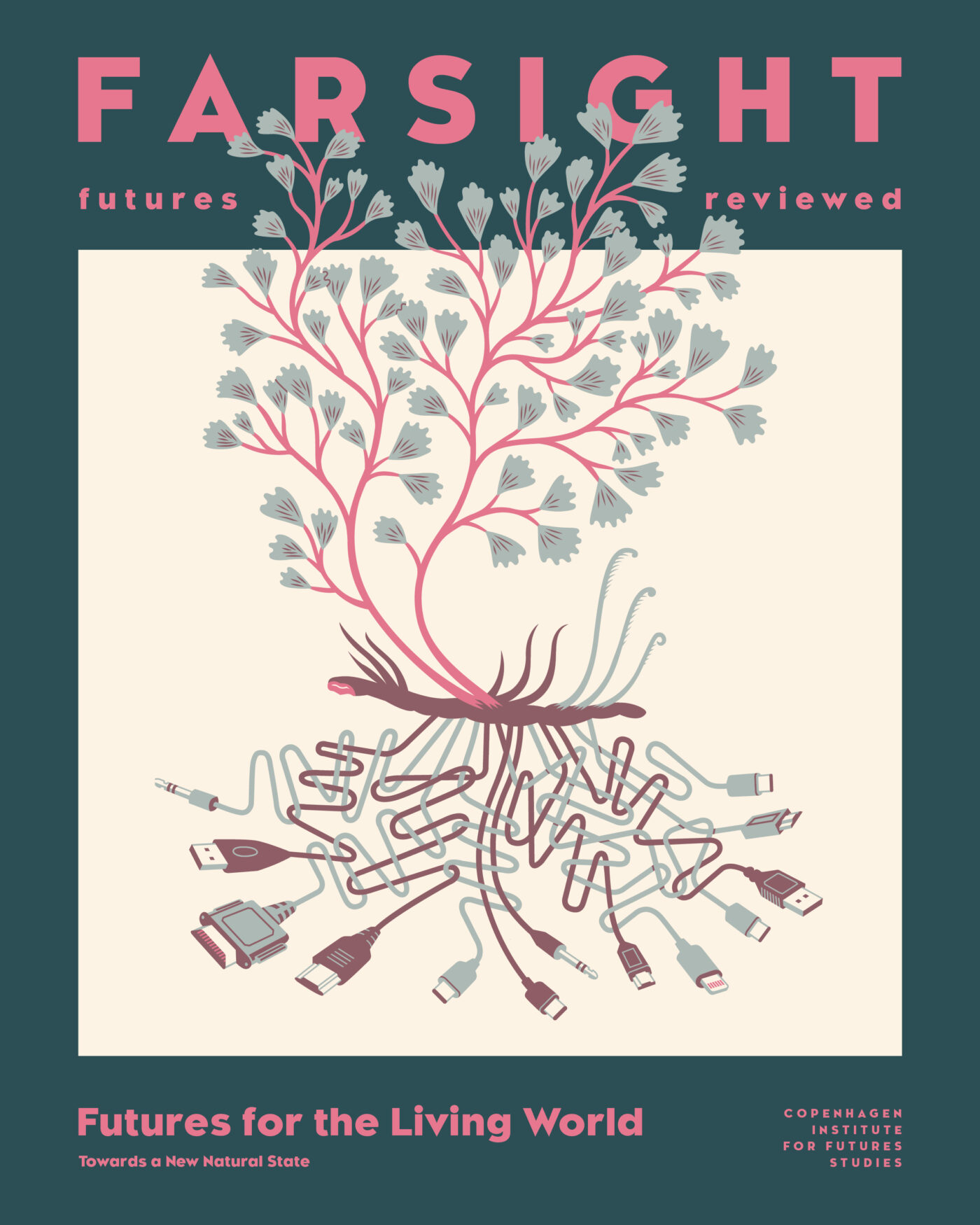
In turn, we use cookies to measure and obtain statistical data about the navigation of the users. You can configure and accept the use of the cookies, and modify your consent options, at any time.

The New Frontiers of Biomimicry
A possible and unexpected future for fashion,
inspired by decay in the natural world
‘Green’ has perhaps been the most fashionable trend in the clothing industry in recent years. With increasing consumer concern over whether our wardrobes can be considered ‘sustainable’, there has been a rush amongst retailers to provide the market with options both innovative and thematic: sneakers made from recycled shoes; sweaters made from textile factory off-cuts; swimwear made from recycled plastic gathered from the sea – ‘saving the ocean, one bikini at a time’.
Beyond this consumer pressure, there has also been a concerted push amongst environmentalists and policymakers for whole-system change towards a ‘circular fashion’ model, a shift that aims to combat the 92 million tonnes of textile waste created each year on a global scale. It’s an idea that has quickly taken hold. Hailed as the solution to the vastly over-polluting and unsustainable status quo, it would form part of a wider ‘circular economy’; a system in which we intentionally and thoughtfully design products with low-impact materials, for longer-life, easy reuse and disassembly, with the ultimate ambition to effectively ‘design-out waste’.
There’s much in circular economy to like, but it can be criticised for leaning towards the unrealistic. To this end, a few expert voices are concerned to point out that these ambitions for a circular system fail to address an inherent issue: the fact that our man-made material loops always, inevitably, leak.
In an attempt to address this issue, the Biomimicry Institute has been developing a new initiative that instead looks to nature for how we can cooperate with the natural laws and draw inspiration from nature’s own solutions. The theory being that if we accept a world in which loss is inevitable, a more obvious solution to the problem of textile pollution presents itself.
Forget ‘design for re-use’; enter-in ‘design for decomposition’.

Megan Schuknecht, a Senior Biomimicry Professional and biologist, gives us her thoughts on how this project proposes nothing less than a complete turnaround for fashion.
In Futurist literature we’ve become quite accustomed to seeing biomimicry principles and technologies applied in pursuit of architectural and medical innovation. But applying biomimetics to a systems process seems a new angle – and acknowledging decomposition feels a radical shift for an industry that is so focused on the ‘new’. How did the Institute come to this unique approach?
The project stems from a concern to recognise that everything we do – all our industrial and economic activity – exists within the planetary natural system. When you start there, it is obvious: the same laws of physics that disperse seeds far and wide also ensure we can never prevent man-made materials escaping into ecosystems. Entropy demands that everything scatters, and that’s why there are now PFAS chemicals in the blood of polar bears and plastic in all of our bodies. These principles can’t help but be applied to the system; they are the system itself. From there we take an additional step to see, with this as our understanding, what we can then learn from nature. What we are seeking to do is to turn all those neglected carbon molecules from the clothing surplus back into something useful for the biosphere.
Companies such as Novobiom and Mycocycle for example, are leveraging the power of fungi, nature’s champion decomposers, to remediate waste and toxic constituents. In the case of Novobiom, toxic sites are left with cleaner soils, while Mycocycle’s process renders a renewable byproduct that can be turned into new products for industrial or commercial use. Those companies aren’t working on textiles yet, but we are looking at several fungi-based solutions as potential technologies to pilot as part of our Design for Decomposition initiative.
It’s certainly a novel approach to look at clothing production from an end-of-life perspective. Why do you think there is a need for this shift in the fashion industry?
For me the biggest issues stem from the fact that we now rely on fossil fuels to produce much of our clothing. If we were only growing natural materials to use in fashion, there would be corresponding natural limitations to what we could make. Also relevant here are the social issues inherent to the industry. In biomimicry we don’t focus on these directly, but they are part of the ecosystem as it is petrochemicals and the rise of fast fashion that have allowed for the abuse of workers – from the production side all the way through to the disposal end of fashion. We also need to recognise that even the natural fibres within our system cause problems – particularly when grown using industrial practices. Cotton growing requires incredible amounts of water and pesticides, so the problem isn’t limited to fossil fuels, but it is petrochemical use that has allowed for this abusive system to become widespread. This issue is insurmountable without systemic change.
We are now in a situation where 60% of the world’s clothing is made using fossil fuels that we also use to coat, waterproof, and dye textiles. We’ve seen examples already of the insidious side-effects when these leak-out into nature. Take microfibral shedding for example. Once those plastic fibres are dispersed in our soil, air, and oceans, it’s very hard to treat their negative repercussions.
Looking at this from an evolutionary perspective, if plastic were the only material around, then there ultimately would be organisms that would figure out how to eat those plastics, but we don’t have the luxury of this kind of time-scale. And when we look at nature’s examples, it would clearly be a mistake to wait in hope of one miracle enzyme. We need to be able to work with mixed materials, just as nature does, and consciously provide the environment for a consortium of microbes that will help us break things down.
John Todd Ecological Design’s solutions for treating wastewater and remediating degraded water bodies are a great example of this. Their systems use biodiversity and sunlight to mimic natural break down processes, producing only natural gases and biological materials as by-products. The solutions don’t rely on separating out cellulose, oils, pesticides, and so on, although breakdown may happen sequentially, depending on what is in the water.6
Are there other ways in which we can re-think the fashion industry, taking inspiration from natural systems?
One of the central themes from our work on The Nature of Fashion – Moving Towards a Regenerative System, is that ‘Nature doesn’t sort, it disperses’. We know this, and yet we seem surprised by the microfiber issue. And the problem is far from disappearing despite the growth in sustainable initiatives from retailers. When you look at the statistics, many are expecting our consumption to increase over 60% between 2015 and 2030. So far we have been dealing with this issue by encouraging reuse and through recycling. But even in the current ‘best case scenario’ – when multiple different consumers use the same piece, at some point, it ends up as waste or is incinerated. And what we’re looking at here is a true surplus. Whilst globally too many people don’t have water, food, or security, they have clothing almost everywhere. In Design for Decomposition we address these questions: what can we do with the existing waste, and how can we design a more biocompatible system? Because we shouldn’t have to be worried when something escapes into the environment. If a tree loses a leaf, and a child comes and picks it up, carries it over to the stream and sends it down, that’s a macro form of dispersal, but it’s not going to be a problem. And moreover, we need to be looking at how we can break down polymers to small constituent components and give those parts new life in other parts of the value chain. In fashion, there’s a current emphasis on textile-to-textile recycling, but when nature recycles, a branch doesn’t become a branch again.
There is a great potential for biomimicry, for example, by looking at how nature does chemistry. John Warner, considered one of the fathers of green chemistry, recently made the claim that “nature doesn’t care about mixtures”. What he means is that Nature has figured out a way to decompose mixtures, breaking down some materials and using them to build others. Until humans embrace that, we will constantly run up against problems.
How can we approach the mixtures of nature and let them inspire our design solutions?
Within textile production we already have some excellent examples of successful biomimetic design. ‘Velcro’ is one such case, where the structure is a based on that of the burrs from the burdock plant. In biomimicry we talk about mimicking form, mimicking process, and mimicking systems. Velcro really only mimics the form and is still produced using petrochemicals. So we can see that biomimicry exists on a gradient, and the aspiration is to mimic the whole system.
An example of system mimicry can be seen in the efforts of global carpet manufacturer Interface, one of the companies participating in Project Positive, an initiative by the Institute’s consulting company. They are exploring how their factories could function like the natural ecosystem in which they reside. The vision is to answer the question: how can a factory function like a forest? And whilst aspirational, in many ways it is also inherently simple. At the heart of nature is a system of cooperation and efficiency – and we should also be aiming for an environment of cooperation in business and development. Somehow in nature it’s also clearer to us that it takes energy to gain resources, and the energy efficiency we see in nature, could be considered a ‘deeper pattern’. The secret to proper efficient design relies on these deep patterns. Nature often achieves performance through structure. Is it possible to do the same with our clothing? Can we get water proofing or wrinkle-free clothing by applying cross-linking or other structural solutions? Take the beetle as an example: its shell is wonderfully durable, lightweight, and colourful, but when it dies, it also disappears quickly. And the beetle accomplishes all those functions without toxic coatings, additives, or dyes.
And there are many extremely promising advancements in the field: Helicoid Industries has mimicked the helicoid structure of a Mantis shrimp’s clubs to create a strong, lightweight material for wind turbines, cars, and even aeroplanes. By copying the helicoid structure of the shrimp’s clubs, we need far fewer resources to create equally strong materials. Another company, Werewool, identifies proteins that convey colour and other performance characteristics in nature and grow fibers that have those specific characteristics embedded within them.
Why haven’t we done this sooner?
In part it’s human hubris. We tend to believe that we have all of the answers. We were better at looking to nature when people had to acquire resources more directly and when we weren’t able to outsource the impacts to externally remote places. In biomimicry, we talk about the need to ‘quiet our cleverness’ as a key principle. We need to stop the chatter, look to nature for answers, and be open to how nature does things. Once we have done that, we can apply all our human ingenuity to emulate what we see in the natural systems. Now that we are finally starting to acknowledge that climate change is happening, we are able to take the first steps down this path. But a missing piece remains in the lack of incentives to engender the behaviour we want to see. A further challenge still is tackling the issue of rampant consumerism. The reality is that until we hit a real barrier, humans will keep consuming beyond nature’s means. This stalls our progress.
Nonetheless, with the right policies in place and some leadership from major brands, I think we could be very close to a biocompatible system in 30 years. We are this ingenious species, and we are at a point where we have a lot of models for how to design-in performance to materials. The lessons in nature are there for the taking.

For more articles like this, read the issue FARSIGHT: Futures for the Living World